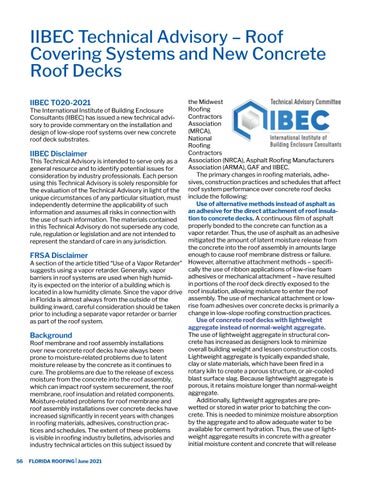IIBEC Technical Advisory – Roof Covering Systems and New Concrete Roof Decks the Midwest Roofing The International Institute of Building Enclosure Contractors Consultants (IIBEC) has issued a new technical adviAssociation sory to provide commentary on the installation and (MRCA), design of low-slope roof systems over new concrete National roof deck substrates. Roofing Contractors IIBEC Disclaimer Association (NRCA), Asphalt Roofing Manufacturers This Technical Advisory is intended to serve only as a Association (ARMA), GAF and IIBEC. general resource and to identify potential issues for The primary changes in roofing materials, adheconsideration by industry professionals. Each person sives, construction practices and schedules that affect using this Technical Advisory is solely responsible for roof system performance over concrete roof decks the evaluation of the Technical Advisory in light of the include the following: unique circumstances of any particular situation, must Use of alternative methods instead of asphalt as independently determine the applicability of such an adhesive for the direct attachment of roof insulainformation and assumes all risks in connection with tion to concrete decks. A continuous film of asphalt the use of such information. The materials contained properly bonded to the concrete can function as a in this Technical Advisory do not supersede any code, vapor retarder. Thus, the use of asphalt as an adhesive rule, regulation or legislation and are not intended to mitigated the amount of latent moisture release from represent the standard of care in any jurisdiction. the concrete into the roof assembly in amounts large enough to cause roof membrane distress or failure. FRSA Disclaimer A section of the article titled “Use of a Vapor Retarder” However, alternative attachment methods – specifically the use of ribbon applications of low-rise foam suggests using a vapor retarder. Generally, vapor adhesives or mechanical attachment – have resulted barriers in roof systems are used when high humidin portions of the roof deck directly exposed to the ity is expected on the interior of a building which is located in a low humidity climate. Since the vapor drive roof insulation, allowing moisture to enter the roof assembly. The use of mechanical attachment or lowin Florida is almost always from the outside of the building inward, careful consideration should be taken rise foam adhesives over concrete decks is primarily a change in low-slope roofing construction practices. prior to including a separate vapor retarder or barrier Use of concrete roof decks with lightweight as part of the roof system. aggregate instead of normal-weight aggregate. The use of lightweight aggregate in structural conBackground crete has increased as designers look to minimize Roof membrane and roof assembly installations overall building weight and lessen construction costs. over new concrete roof decks have always been Lightweight aggregate is typically expanded shale, prone to moisture-related problems due to latent clay or slate materials, which have been fired in a moisture release by the concrete as it continues to rotary kiln to create a porous structure, or air-cooled cure. The problems are due to the release of excess blast surface slag. Because lightweight aggregate is moisture from the concrete into the roof assembly, porous, it retains moisture longer than normal-weight which can impact roof system securement, the roof aggregate. membrane, roof insulation and related components. Additionally, lightweight aggregates are preMoisture-related problems for roof membrane and wetted or stored in water prior to batching the conroof assembly installations over concrete decks have crete. This is needed to minimize moisture absorption increased significantly in recent years with changes by the aggregate and to allow adequate water to be in roofing materials, adhesives, construction pracavailable for cement hydration. Thus, the use of lighttices and schedules. The extent of these problems weight aggregate results in concrete with a greater is visible in roofing industry bulletins, advisories and initial moisture content and concrete that will release industry technical articles on this subject issued by
IIBEC T020-2021
56
FLORIDA ROOFING | June 2021
